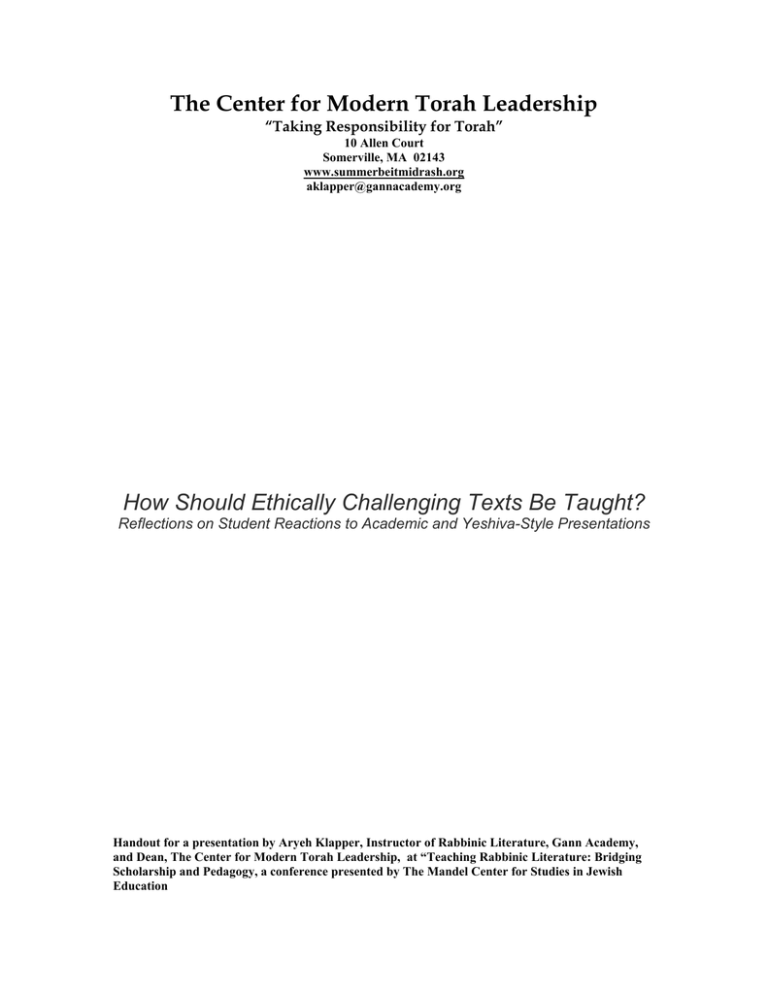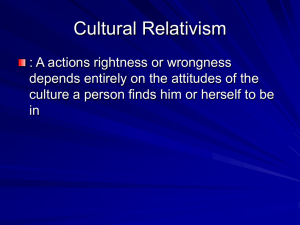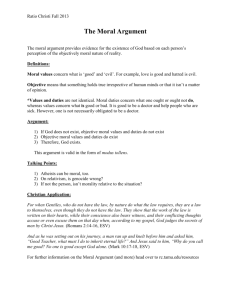The Center for Modern Torah Leadership “Taking Responsibility for Torah”
advertisement

The Center for Modern Torah Leadership “Taking Responsibility for Torah” 10 Allen Court Somerville, MA 02143 www.summerbeitmidrash.org aklapper@gannacademy.org How Should Ethically Challenging Texts Be Taught? Reflections on Student Reactions to Academic and Yeshiva-Style Presentations Handout for a presentation by Aryeh Klapper, Instructor of Rabbinic Literature, Gann Academy, and Dean, The Center for Modern Torah Leadership, at “Teaching Rabbinic Literature: Bridging Scholarship and Pedagogy, a conference presented by The Mandel Center for Studies in Jewish Education Sample student responses A. Validating their own positions in a Jewish context 1. The problem with teaching the shor shel Yisrael sugya in Bava Kama 38a to a tenth grade class at Gann is that they will categorically reject the sentiment that Jews can discriminate against Gentiles in the matter of goring oxen. After all, in the modern world where Jews and Gentiles live as neighbors, and where many Gannites went to school with Gentiles up until high school, a tenth grade class would have trouble thinking that their tradition is unfair to Gentiles. Furthermore, the many interpretations of amad veyemoded aretz ra’ah vayater goyim that are introduced in our sugya by the Rabbis all discriminate against Gentiles. A teacher needs to find a way to ameliorate the revulsion that this discrimination will create in the tenth graders . . . The other sugya that is important to read in the tenth grade classroom is the parallel shor shel Yisrael sugya in the Talmud Yerushalmi. The key part of this sugya is where Rabban Gamliel changes the Halacha of objects being stolen from Gentiles because the Roman officials told him that it was not beautiful. The reason this rectification is so important is because it opposes the stark partiality of the same sugya in the Bavli. Where in the Bavli no one changes the Halacha based on what the Gentiles say, the Yerushalmi does change the Halacha. This is so crucial because it is saying that even though the sugya discriminates against Gentiles, [the students’] opinions can still be valid, as proved when Rabban Gamliel rectifies the Halacha. 2. I would teach them the parallel text from the Yerushalmi and the other texts that helped us to see the hidden voices who had moral arguments against our mishneh. Despite the argument that finding a moral argument in the text can undermine our ability to support that argument, I think that for many of the students at Gann, they would rather know that some of the writers of the Talmud felt the same way that they do about how to relate to gentiles then find a way to lawfully justify a law that, from their life, they cannot understand. 3. I also think it is very important to teach the argument that there is in fact a minority opinion that has moral problems with the Shor shel yisrael etc sugya. It could be easy to be put off by this sugya and one might think that any traditional scholar agrees with the obvious prejudices towards gentiles expressed in this sugya. Therefore, we must show that there may have been a group of equally informed and smart scholars who also saw a problem with this text. 4. To respond to the first statement, I think that by knowing that the tannaim had underlying intentions of morality, it does not make the text any more controversial. In fact, if there was no hint of a moral problem, and it was simply intellectual, it would be harder to justify the text. This is because without the concern of morality, it would seem as though the people writing the sugya did not care about the moral aspect which is worse than the way that gentiles are treated in it. 5. I think that, in order to teach this Mishnah, it is important to teach the alternative viewpoint, because it is important not to leave people thinking that Judaism is inherently racist. 6. I think one of the most important things to point out is in the Yerushalmi, how Rabban Gamliel too knows that there is a moral problem with how Jews treat non Jews. This way, the students are less concerned with the fact that it seems like the Rabbis and maybe even Judaism think lowly of non Jews, since the Great Rabban Gamliel also notices this problem. B. Looking to change the majority position (Note: this position is probably more committed to the texts than A. 1. However, even if one were to say that the arguments we have are not new at all, but rather are the exact same as those made by the Tannaim, that does not necessarily mean that we cannot accept those arguments too. There are two opinions given as to why the Talmud included the minority opinions and the hidden voices such as the one that we have discovered in this text. The first is that it is so that someone else years after the text was written will think that they have come up with a superior argument that unknown to them was actually discovered and rejected years ago. The second, which in this situation I think is easier to apply, is that they are so that some day after the text was written, if the minority opinion is found to be more relevant, it can be accepted. 2. While it is possible to argue that since there are minority voices in the gemara and therefore we must be even more careful with our conclusions today because we can no longer argue that the Rabbis were unaware of our ethical discomfort, however the evidence is that these voices were included to validate them. Firstly, the mishnah in Eduyot presents two positions for why we preserve minority voices. The first is that we record the minority voices to so that later on, we know not to follow them. Today, we should dismiss the minority voices because they were the minority, and therefore must have been inferior. This is the basis for the position that the minority voices make it harder to overrule the mishnah in our day. The second position in Eduyot is that the minority positions are there so that we can rule them in later on. Under this assumption, discovering these voices is a plus. However, this was not the majority position of the mishnah, and we don’t need to rely on it to prove that the minority voices strengthen the argument against the discrimination against non-Jews . . . Assuming that the Yerushalmi text came first, and that the changes between the Bavli and the Yirushalmi were intentional, the Bavli preferred to frame the critique as intellectual rather than moral. This may be because the editors of the Bavli agreed with Professor Halivni’s argument that once you frame a critique of halacha as moral, that means that there is something external more important than halacha, and therefore the response is to get defensive and not change the halacha. Therefore, the Bavli changed the argument to allow for these voices so that the laws regarding Jewish-gentile relations. The Bavli also included stories that critique the laws so that the moral critique would be more subtle, and coming from the reader. That way, the moral critique is there, but not such that the issues freeze. 3. In response to the first statement, I think it is generally fair to say that a halakhah would be hard to change nowadays if the rabbis back then seemed to understand the moral (in our case discrimination) issue involved. But if we look at the argument from a deconstructionist point of view, or better yet, an antideconstructionist point of view, we see that the "suppressed ethical voice" in the Babylonian Talmud is only read into the text as opposed to actually being expressed in words. As with all deconstructionist readings that can supposedly bring out of the text whatever opinion the reader desires, we must be careful not to stake too much on a claim of a hidden implication that may not have been fully intended. Since the ethical voice is not explicitly recorded in the text, this might be an instance where it would not destroy the system to value ethics over halakhah, since the suppressed ethical voice can be treated as having less than 100% halakhic authority due to its indefinite nature. This view would make it possible to override the halakhic ruling now in favor of a less discriminatory policy, instead of outlawing the change only because of a somewhat indefinite implication. 4. In the interest of honesty about what I think, although I used Professor Halivni's argument because it worked for what I was saying, I actually find his argument very troubling. I think that when there is a moral critique of halacha, the response should not be to refuse to change the halacha because that validates the idea that there are morals external to halacha, the response should be to evaluate the critique from the standpoint of Jewish morals. As we know from the story of Daniel the Tailor, there are Jewish moral concerns that are not incorporated into halacha. The idea that every moral critique is external to the halachic system is deeply problematic because there are Jewish morals separate from the way the law might be currently. C. Liking Apologetic 1. While teaching this sugya, perhaps it is natural to feel the ethical problems with the apparent superiority Judaism has over other religions. It is of utmost importance that the students understand that such is not the case. R. Yaakov Kaminetsky's commentary should come in here, as he explains that the texts are not self-exalting. 2. Also, studying modern commentaries, like the last one we studied today, which says we shouldn’t take their money just because we can, is important, so that we know not only how they thought about non Jews earlier, but also how WE think about them now. D. Wrestling 1. After learning the intellectual argument in the Bavli, I think that it's even more important to learn the moral argument in the Yerushalmi. By bringing up the moral argument, students are challenged to come up with a way to solve these types of problems in Jewish texts. Perhaps not to solve them for good, but to recognize that these types of moral problems exist in the Talmud and one must get to a point where one can at least begin to reconcile the problem for oneself. By learning the moral argument, especially this particular one about how Jews relate to gentiles, students are able to dig deeper into themselves and decide what they think about these matters. 2. As for big-picture issues, there are two that we talked about in class that I think are appropriate to bring up in the study of this sugya: the role of and rationale behind the preservation of minority opinions in the Talmud, and the conflict Halakhah has with the external laws of morality. Both of these issues were brought up in our study of the passage from Bava Kamma about the Romans criticizing certain statements in the Talmud. Not only is this a very interesting notion -- the presence of inherent danger in changing halakhah for moral reasons -- but it is also a very important one that provides a new way to think about the laws of our people. 3. This would seem like a hindrance to the progression of modern halacha. However, it merely reinforces the idea that the Tannaim and Amoraim and rishonim all were thinking about gentiles empathetically when they wrote the laws, thus making it easier for us to accept the laws. It also prevents the modern Jewish thinker from making a change to a law and basing it solely on the lack of sympathy toward gentiles in earlier times. So, in actuality, the discovery of this law will ultimately make Jewish law a more correct and accurate code than it would otherwise have been. 4. I think that one of the most important texts to teach is the Yerushalmi version of our sugya. I think it is important to learn that you are allowed to not take the Bavli as fact and that you are allowed to get different things out of learning Talmud . . . 5. I think it is important to teach the interpretation of our sugya in which the "gentile" is replaced with "convert." I think that this is crucial because it points out the fact that different "versions" of the Talmud in fact exist, and that we therefore cannot assume that our first reading of a text is correct 6. I think that I would have the students struggle with the double standard (or agree with it) and possibly write a paper trying to understand the sugya without help from deconstruction. I'd try to place a lot of emphasis on the moral problems. Next, after the students have thought about the moral problems with the sugya, I would then and only then introduce them to the Yerushalmi text. I would show those who felt the moral problem with the double standard that there are people who agree with them, and that they are not alone: that there is legitimacy to thinking about morality when following Halakha. Ultimately, I would show them the more modern texts, showing them how the sugya is understood in different places in different times. Hopefully, I'd get the students to understand that what the Bavli says does not always need to be taken as fact, and that sometimes studying something the first and second and third time does not always yield the answer that you are looking for. I also think that this sugya is sort of very dangerous, and should not be taught to immature 10th graders. If someone were to teach this to an immature 10th grader, they could give up wholly on Halakhah and Judaism just based on the first mishnah and sections of the gemara, and wouldn't have the patience to see that the Bavli is not always right. Overall, I think the unit is dangerous, and should be taught in a later year when dedication to Judaism is more cemented and guaranteed. 7. I think that one of the most important parts of this sugya to teach is the Yerushalmi version. Without that, we wouldn't have come up with the idea that the reason not to answer the intellectual questions in the Bavli was in fact to get people to ask their own questions about the moral aspect, because there would have been no version about the morality to compare the Bavli to. Without finding the differences between the two, we would never have wondered about why the memah nafshakh was there, or why it wasn't sufficiently answered. Also, I think that it is important to teach the sugya about the order of whose life to save first. Not only is this text an important one to learn due to the fact that it is so controversial, but it also shows, if you agree with Rav Aryeh's argument which I do, that what matters most in determining the value of each person's life is not their status, but the amount of Torah that they learned. 8. I think the reason that the Bavli present the Romans’ critique as intellectual rather than moral is because this way it is showing that what the Torah is saying is true- and that it was just the interpretation that was misunderstood. This way, Bavli is portraying the Romans as believing that the entire Torah is true and that the reason they think the interpretation of the mishnah, isn't because they are offended that the law discriminates against them, but they actually show the verse with “Re'ehu” that it was a misinterpretation of the verse. It is important to the Bavli that the Roman's view what the Rabbis have interpreted as wrong, and not the verse, to fulfill the verses in Deuteronomy that talk about other nations understanding that the Torah is true. Like it says in Deuteronomy, verse 6, (JPS translation) “Observe therefore and do them; for this is your wisdom and your understanding in the sight of the peoples, that, when they hear all these statutes, shall say: 'Surely this great nation is a wise and understanding people.”.






